Naxo randonnee alpine touring AT ski binding FAQ
Frequently Asked Questions
As well as the info below, please see our extensive NAXO content.
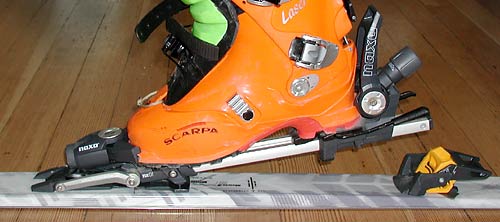
Naxo binding in touring mode, showing double toe pivot at first stage of stride. The double pivot allows a somewhat natural stride, but more, it allows the use of a full size alpine-like toe. The binding weighs about the same as a Diamir Freeride, and is sold with brakes. Heel lifter is designed so that the binding can not accidentally switch to touring mode while alpine skiing — a concern of some hard cores.
(Please note, Naxo ski touring binding is an orphaned and discontinued product, though it may be available on the used and remainders market. The binding was first released in 2004, and was last manufactured around 2008. This information is published for historical reference, WildSnow.com does not recommend using older or orphaned ski bindings.)
What is the Naxo Binding?
The Naxo NX01 and NX21 are AT ski bindings from Switzerland. They have a maximum release “DIN” setting of 12 and 13 (respectively) in the medium and large sizes, and an innovative walking pivot that improves stride ergonomics while touring and allows the use of an alpine-like toe unit.
This backcountry skiing binding is sold in two models. The NXO1 is slightly lighter but allows quite a bit of boot movement, the NX21 is stiffer and slightly heavier.

Naxo binding in touring mode, showing double toe pivot at first stage of stride. The double pivot allows a somewhat natural stride, but more, it allows the use of a full size alpine-like toe. The binding weighs about the same as a Diamir Freeride, and is sold with brakes. Heel lifter is designed so that the binding can not accidentally switch to touring mode while alpine skiing — a concern of some hard cores.
How can I tell the difference between the 2003/2004 and 2004/2005 models of the NXO1?
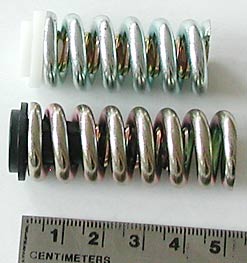
Naxo vertical release springs, photo is slightly distorted, older model at top measures 4 cm.
Before reading this, check our Naxo First Look article for the new model. The improved latest model is virtually identical in appearance to the 2003/2004, but has many structural changes for increased strength, stronger plastic and a longer vertical release spring in the heel unit. The easiest way to ID the bindings is simply look at the model name printed on the side of the frame below the toe. Early models will say “NX01,” while the 04/05 model will say ” NX01 VRS” Another way to ID your bindings: Unscrew the cap of the spring barrel in the heel unit, then examine and measure the springs (a larger one with a smaller spring inside it). The older model external spring is 4 centimeters long, with an internal spring that’s approx. 4.6 cm long. The newer model external spring is about a centimeter longer, with a much differently sized internal spring with a different shaped plastic plunger. See below for more information about reasons for latest model improvements. If a ski shop person knows the above info, buy them a 6-pack.
Who makes the Naxo binding?
The binding was developed by Naxo AG of Thun, Switzerland, a company founded in 2001 by former managers at alpine touring manufacturer, Fritschi AG. Naxo was introduced to the European market during the 2002-03 season, and imported to the U.S. for the 2003-04 season by Backcountry Access. The binding was discontinued circa 2008.
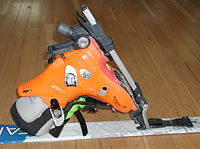
Naxo pivot allows virtually unencumbered forward movement, even with a long alpine-like toe unit. At the least, this prevents any chance of ripping the binding out of the ski during a forward fall while touring.
What makes the Naxo special?
This is a tour binding designed for skiers who want a “real” alpine ski resort rig. The crux of the Naxo design is its beefy toepiece and a unique touring (heel lift) pivot system. By providing two walking pivot points, one beneath and one in front of the binding toe, the system allows for a full-sized alpine-style binding toe. It also creates a more rounded gait, reducing the somewhat awkward stride that may be experienced with existing AT plate bindings. In addition, the heel piece locks down in such a way that it cannot prerelease due to flex of the ski, and the touring heel lifter can’t be inadvertently raised while downhill skiing. Binding length and spring tension at the toe and heel can be adjusted quickly, making the Naxo ideal for rental use or swapping between partners during an expedition.
How much do Naxo bindings weigh?
One size medium 04/05 Naxo NX01binding, with brake and screws: 39.8 ounces, 1128 grams
One size medium 05/06 Naxo NX21, with brake and screws: 42 ounces
What boots will the Naxo work with?
Virtually all modern ski boots — randonee or alpine. The Naxo toe unit has a wide-range height adjustment. Adjust it high for rocker sole AT boots, or low for standard alpine boots. An anti friction device (AFD) just behind the toe jaw allows any boot to release to the side without dangerous resistance. The AFD is angled so it interacts well with the curve of rocker sole AT boots. Nonetheless, as with other randonnee bindings, it may be necessary to grind rubber off your AT boot sole to gain a solid platform fit on the AFD, as well as to drop your boot toe a few millimeters to add more ramp angle to your stance. The Naxo will not work with climbing boots that don’t have a standard DIN ski boot shaped sole, but a toe jaw adapter that fits climbing boots may become available.
Note: Some randonee boots may come from the factory with their sole the wrong shape to correctly trigger closure of the Naxo step-in heel. This can usually be fixed by grinding a small amount of rubber off the boot sole. If you want to get technical, the DIN (see below) standard for Randonnée boot heel sole thickness is 32 mm, plus or minus 3 mm. This standard is now bent to the thin side, with most AT rando boots coming from the factory with soles at about 30 mm at the heel. In one sense this is a good thing, as modern boots can be manufactured with thinner soles for lighter weight. The Naxo is made for boots with this more common heel thickness. More, the Naxo closes when the heel of your boot engages a small tab. If there is a bevel on the heel of your boot, this tab may not engage correctly. If you suspect this bevel is causing problems with closure, try building it up with boot sole repair material such as Shoe Goo, along with grinding a bit of thickness off the sole.
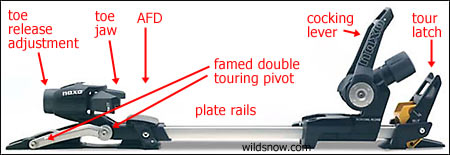
Is the Naxo really equivalent to a state-of-the art alpine binding?
The honest answer is “nearly, ” especially if you’re talking about the stiffer and stronger NX21 model. Thousands of happy skiers can testify that the Naxo and the Fritschi Freeride certainly come close to the safety and performance of top line alpine bindings. Nonetheless, some alpine bindings offer features such as compensation for upward release forces at the toe (to protect your knees in a rearward fall), and and lighter weight plate bindings such as the NX01 can’t equal the solid boot/ski connection of a regular high quality alpine binding, especially when it comes to sideways twisting forces that tend to deflect the plate. This latter factor is where performance skiers will notice the difference between using the Naxo NX01 and their beefy alpine rig, especially on hardpack. The NX01 will deflect more, and may take some getting used to (while the NX21 is just as stable as a good quality recreational alpine binding, as is the Fritschi Freeride).
Is the front touring pivot and mounting plate weak?
Any astute observer of randonnee bindings will notice the tiny front pivot of the Naxo. I torture tested this part of the binding, and it’s incredibly strong. Nonetheless, Naxo has strengthened this area on all current models. What’s happening with bindings is that plastic technology has improved by leaps and bounds over the past years, and plastics such as those in the Naxo are incredibly tough. More, during a forward fall while in touring mode with Naxo bindings your knee will contact the ski before the binding gets stressed (because of the double pivot), this goes a long way in preventing damage to the binding.
Any durability issues?
The Naxo has been skied hard by aggressive bump skiers, and consumer reports are appearing. Thus far, no major durability issues have risen (early 2003 production runs had durability problems, but those appear to be a thing of the past). As with any ski binding, alpine or touring, if you bash the Naxo into rocks, or hit it hard with a ski, you can nuke parts.
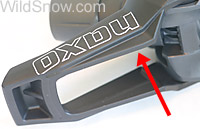
Naxo heel lever, beefed in later versions.
The most vulnerable part of the Naxo appears to be the cocking lever (see photo above). It is long, the plastic is thin, and when you you step into the binding the cocking lever snaps forward at hyper velocity. While breakage of this part is not common, it was being reported during this 03/04 season. Naxo has strengthened this this part on the 04/05 model. Along with that, they’ve also strengthened several parts in the toe area that broke on rare occasions during the 03/04 winter season. This strengthening was done by using different plastic and slightly changing the molding shape, while adding about 1 ounce of weight per binding.
Two issues regarding cocking lever breakage: If the cocking lever happens to hit something during its movement, and it’s already damaged or below zero cold, it could break. Also, if instead of pushing with a ski pole tip you use your foot or a ski to stomp down on the cocking lever to remove the binding, doing so can place quite a bit of force on the lever, and may break it. Thus, when setting up your Naxos make sure the cocking lever is free to snap forward without hitting the rear part of your boots, and don’t go wild when you stomp down on the lever — especially in colder temperatures.
Another durability issue with the Naxo, as well as with bindings such as the Fritschi models, is that adjusting the toe jaws too low and tight may damage the binding toe unit. It is critical to set the toe jaws perfectly. During the 03/04 season a number of people had a toe unit break completely off the Naxo binding, thus totally disabling the binding. While this may have been caused by improper adjustment, it is also possible that defective plastic was the culprit. In any case, as I say below, at this juncture don’t buy anything but 04/05 season Naxo bindings, and adjust all bindings correctly!
If you own the 03/04 Naxo, adjust the toe height correctly, and don’t abuse the binding, it is strong enough for normal North American use excluding expeditions and extreme cold such as Denali climbs.
Again, remember that all bindings (and ski poles, and skis, etc.) break when subjected to various forms of excessive abuse and over-aggressive operation, especially at colder temperatures. When in the backcountry, treat all your gear with respect — your life depends on it. If you like to bragg about breaking randonnee gear, you might want to look in the mirror for the problem, not at the gear — and consider switching to race proven alpine gear combined with Alpine Trekker touring adapters.
A minor durability issue is that the Naxo binding has two active rubber bumpers that get rubbed and compressed at every stride. Users who climb major vertical with the Naxo might wear out these bumpers at some point, but they are easily replaced, and the binding would still function if they failed (they appear to just ease out the stride a bit).
I’ve heard all sorts of hype about the Naxo double pivot, should I deify it?
With one walking pivot point, the toe unit of a randonnee plate binding always impacts the ski at some point in the movement range of the binding (while in touring mode).Thus, to allow enough movement range for a touring stride randonnee plate binding toe units are usually stubby and short, and the toe of the boot may end up some distance behind the pivot point, thus resulting in an inefficient gait known as the “Frankenstride,” (after the stride of that well known movie monster).
More, to allow room for the toe while walking, some rando bindings attempt to build their side release mechanism into the heel.
Result of above: the crux goal of designing plate based tour bindings has always been including lateral release that comes close to the elasticity and release characteristics of alpine bindings. This goal was frequently missed in past generations of bindings because of size and weight constraints for the toe unit.
Thankfully, today’s compact randonnee toe units (such as those on the Fritschi Freeride) have evolved to an incredible degree, and probably approach the performance of alpine gear toe release.
Nonetheless, the Naxo double pivot eliminates the issue of the toe unit being obstructed by the ski while the heel is lifted in tour mode, and thus allows the use of a long toe unit containing a compression spring mechanism similar to the best alpine bindings. In my view, this is an important development in AT technology.
Is the Naxo lateral release thus superior to other bindings? There is no way to know the answer without a few seasons of consumer use, along with comparative bench testing. Meanwhile, the beauty of the Naxo system is that as alpine binding technology advances, the Naxo allows space to build things such as upward toe release into the system, using proven alpine technology instead of trying to pack such features into a tiny toe unit. In other words, look for ongoing improvements in the toe release of all randonnee bindings, with Naxo possibly leading the charge.
As for walking performance of the Naxo double pivot: Compared to plate “frame” bindings that place the touring pivot well ahead of your toes the Naxo most certainly adds a comfortable and unique feel to your stride, especially at the beginning when you push off for a step. Nonetheless, whether the double pivot adds any efficiency is an open question. Thousands of randonnee skiers have been perfectly happy with the stride of excellent bindings such as the Fritschi and Dynafit offerings. Those thousands will vote with their feet and wallets if the Naxo stride really does offer more vertical per breath, so we’ll wait and see on that one. Meanwhile, I’m guessing that someone somewhere is actually doing third-party scientific testing on this issue, and it’ll be terrific to see that.
My boot heel moves up and down too easily, causing annoying play while I’m skiing, any cure for this?
If you’re using medium or large size Naxo 03/04 model bindings, and setting your vertical heel release below 7, this behavior is caused by the heel release spring not being under enough tension. Solution may be to use a size small binding, or swap in the spring from a size small. If you’re set above DIN 7 and still experience this behavior, check the binding length setting and make sure your boot heel is not excessively worn. The 2004/2005 model Naxo has significant changes in the vertical release mechanism, presumably to eliminate some of this behavior, see photo to right. More info under the next question.
What is the maximum release “DIN” setting for Naxo bindings?
The Naxo NX01 toe and heel can be cranked up to a DIN 12 (with medium and large binding, small binding max DIN is 9). The NX21 goes to DIN 13. Setting 12 is much higher than most skiers will ever use, but is useful if you’re skiing terrain where loss of a ski can mean death, or you’re jumping off cliffs and trying to ski away from the landing. Aside from being a macho meter, what’s good about higher DIN is it means the binding has plenty of range and elasticity for larger or more aggressive skiers, and that the binding is intended to hold up under aggressive use.
Downside? Skiers using DIN settings below 7 with the medium and large size Naxo (early models) may find their boot has quite a bit of vertical up/down movement at the heel. I’m researching solutions to this, perhaps swapping in the heel spring from the small size Naxo is the fix, or perhaps using the complete heel unit from a size medium on the frame rails of a size small. (If the spring swap works, it will make the DIN setting marks meaningless and release will have to be set using on snow trials as described in the next paragraph.) Again, as shown in the photo above, the 2004/05 Naxo has significant changes in the vertical release springs, presumably to eliminate problems such as those covered above. (As of autmn 2005 it appears the boot play problem is fixed.)
In normal use, if you’re an expert skier a good way to adjust DIN values on an AT binding is to start with settings figured from a release setting chart, then ski moderate terrain at a resort to test. During conservative skiing (not in a wild fall recovery or crazy stunt), if the binding releases when it’s not supposed to (e.g., a “pre release”) dial up the settings in small increments until you’re not pre releasing, but you’re still within the range of the chart. Treat the heel and toe separately. In other words, if you experience a vertical “heel up” pre release, dial up the heel release setting, but leave the toe setting alone. Be aware that falls resulting from pre-release can be dangerous.
The Naxo doesn’t have return springs, should I care?
First, congratulations for actually knowing what a “return spring” is. But if you don’t: Return springs pull your ski tail up to your heel while in touring mode. They may help control your ski tails while side stepping or doing kick turns, but add weight and resistance to your touring stride. Common wisdom holds that touring without return springs is more efficient. The lighter weight uphill biased bindings are sold without return springs (e.g., Dynafit and Silvretta Pure), and Naxo chooses to follow suit. The return springs on bindings such as the Fritschi models are easily removed. We suggest touring without them no matter what bindings you use. As of 2015 no touring bindings we know of have a return spring.
How much do they weigh?
One size medium 2005 NX01 Naxo binding, with brake and screws: 39.8 ounces, 1100 grams
One size mediaum 2005 NX21 Naxo binding, with brake and screws: 41.5 ounces (subject to verification of production model).
One size medium 2004 Fritschi Freeride, with brake and screws: 37.1 ounces, 1050 grams
(Both weighed at same time on Pelouze digital postal scale, Fritschi with return spring removed. Fritschi return springs each weigh .4 oz, 10 grams.)
It looks like the heel lift (for climbing) on the Naxo is somewhat short, true?
The climbing heel lift/latch all randonnee bindings are judged by is that of the Fritischi models — a 4-position lift, with super-high final position. I compared the Naxo (has 3 positions) to the Fritschi Diamir. The max height of the Naxo is about 1 centimeter lower than the Fritschi (tested with 29 cm boot sole, medium size binding). If you are a super aggressive backcountry uphiller, no doubt the higher lift of the Diamir, along with one extra choice in lift height, may be helpful. On the other hand, folks who favor the Naxo say the double pivot compensates for the lower heel lift, and they say the Naxo thus has enough lift. In my experience, I found the Naxo lift height to be fine for most tours, but did occasionally wish for a bit more height. (Interestingly, the Naxo lift is higher than the Diamir in the 2nd position (one above flat on the ski.) A fun homebrew mod would be to make a small height increasing adapter for the Naxo heel lift. Please let me know of any efforts in this area.
But why can’t the Naxo just have some extra height on the heel lift?
Explained to me by the powers that be: The ethos of the Naxo is to make no compromises for downhill performance. To that end, the Naxo touring latch/lift is designed to absolutely not flip to touring mode while downhill skiing. The longer the lift/lever is, the more easily this can happen — thus, the Naxo has a shorter lift/lever.
Does the Naxo allow my ski to flex while downhill skiing?
Some randonnee bindings, especially those of older vintage, may cause a “dead” spot in skis because the binding plate or boot jams and “bottoms out” between the fixed toe and heel unit when the ski is deeply flexed in a turn or landing a jump. This behavior can cause everything from compromised ski performance, to breakage, to unintended ejection from the binding. Most of today’s bindings compensate for ski flex to some degree, but larger skiers on flexible skis my exceed limits and bottom out some binding models. It’s easy to observe this behavior. Simply suspend a randonee ski setup between two fixed points, then aggressively flex the ski while observing the heel latch area. If the bindings have any compensation for ski flex, you’ll see for-aft movement somewhere in the mechanism. Flex the ski hard, and you may see the mechanism “bottom out” against something. With the Naxo, the binding plate (“frame”) slides through the heel latch as the ski flexes, with virtually no limit to such movement. This is an excellent feature of the Naxo design and may contribute to the binding’s downhill performance.
Note: Most randonnee bindings allow plenty of movement for ski flex. The only time this “bottoming out” behavior may be a factor is during aggressive skiing, most likely with softer flexing skis. Thus, smaller and less aggressive skiers should ignore this issue while shopping for bindings. Also, observe alpine bindings and you’ll see issues with this behavior are not specific to rando.
How do I adjust Naxo bindings for my boots, and set safety release?
Adjusting Naxos for your boots is easy, but takes a number of steps. You start by adjusting the length between toe and heel unit, then fine-tune the height of the toe jaw, then set your release numbers. NAXO adjustment details here.
When I switch from my alpine rig to Naxos, I’m in the back seat while skiing. I just can’t get forward and feel really awkward. What should I do?
Ramp angle is the difference in height between your toes and heel when you’re standing in your ski boots. It’s a ski boot parameter if you’re boot is off the ski, and a “stance” parameter once you’re clicked into your bindings. Most alpine ski boots have positive ramp angle (heel high). Ski touring randonee boots also have positive ramp angle, but it’s usually not as great as alpine boots. The Naxo has nearly zero ramp angle, as does the Fritschi Freeride. Dynafit bindings have positive ramp angle.
If you ski one set of skis/bindings/boots with a different ramp angle than another, you may have trouble switching gear from day-to-day because your stance changes and you have to adjust your timing and turning style. For example, many skiers use alpine gear with fairly aggressive ramp angles, then switch to Randonnée gear and feel like they’re in the “back seat” because they have much less ramp. Solution: Check the ramp angle of all your boot/binding combinations. If it varies widely, and you have trouble switching gear, consider various modifications to adjust your ramp angles so all your gear is similar (usually add more angle to your rando gear, rather than subtract from your alpine rig). Here are some methods for doing this:
– Use binding or boot shims with your randonee rig to raise your heel. To shim the Naxo heel unit, you’ll need a fairly long shim that the rear binding “feet” can rest on (obvious when looking at binding mounted on ski). Fabricate such from dense plastic, or look for long enough alpine binding shim that can be modified. To change your ramp angle with boot shims, simply add a 1/8 inch or slightly thicker shim under your heel inside your randonee boot. Shimming for ramp angle inside the boot is my least favorite option, as it changes the fit of the boot and detracts from walking comfort.
– With most randonnee boots, grinding rubber off the toe area of the boot sole so it sits lower on the binding is an easy way to change ramp angle (with all but Dynafit bindings), and works well with the Naxo. Grinding rubber of rando boot soles is also an effective way to reduce weight. A disk grinder with a 30 grit sanding disk works well for removing rubber. Do it outdoors and wear a dust mask.
– With Fritschi frame bindings, you can mount the binding without the decorative plastic thingus under the front of the binding, thus dropping the toe enough to make a difference. The Naxo does not have this option. Watch your screw length if you play around with this Fritschi mod.
Note: If you grind your boot soles to change ramp angle or remove weight, and swap your boots between Dynafit bindings and other rando bindings, leave rubber in the “trigger” area of the sole — the area that pushes down on the trigger that closes the Dynafit (and other band tech) binding toe when you step into it. Before grinding, evaluate by snapping the boot into a Dynafit binding and observing which part of the sole contacts that trigger. If you want to go wild with the grinder, you can build up the trigger area on the Dynafit with a small pad of duct tape, or better, a dab of epoxy.
I like wide skis, can I get Naxo ski brakes for my planks?
Naxo bindings are shipped with 94 mm brakes. A 105mm brake is available as an accessory. Either brake can be bent a few millimeters wider, but don’t go wild.
What about ski crampons?
Standard (80mm) and fat (100mm) crampons are available for the Naxo binding. They mount on the binding frame, and thus penetrate less the higher you set your heel lift. In my opinion, aftermarket Sk’Alp crampons mounted directly to the ski are a better choice, provided your skis aren’t too wide for them.
Why buy Naxo when there are lighter weight bindings I can get?
The eternal question in rando binding design is this: Build to be the lightest, or build to ski downhill the best? Every binding is a compromise between those two goals. The Naxo is a compromise to the downhill performance side, while still being somewhat lightweight and efficient due to the latest materials science, along with its comfortable pivot.

3 comments
Thanks for a very informative article. I have a pair of Naxo21 with 88mm min width skis. I would like a pair of crampons for them – can you help or advise?
Hello Alistair, thanks for dropping by! If there is a link, I’ll reinstate. But for now: Adjusting the Naxo release settings is self evident. As to boot sole length, the binding I have here in my collection has millimeter marks on the aluminum bars, and the heel slides fore/aft after flipping up a lever on the front of the heel unit. One would also observe how the boot interacts with the heel unit while entering and exiting the binding, on the workbench, based on prior experience.
ALL THAT SAID, THIS IS AN ANTIQUE BINDING, THAT NEVER PERFORMED PARTICULARLY WELL, AND SOME VERSIONS HAD PROBLEMS WITH BREAKAGE. DO NOT USE FOR SKIING. DOING SO COULD RESULT IN INJURY OR DEATH.
Most of the adjustment info is in the mounting tips:
https://wildsnow.com/16497/naxo-ski-binding-mount-install/
Is there a link missing on how to adjust the binding for boots and safety release settings? Can you re-instate this link please